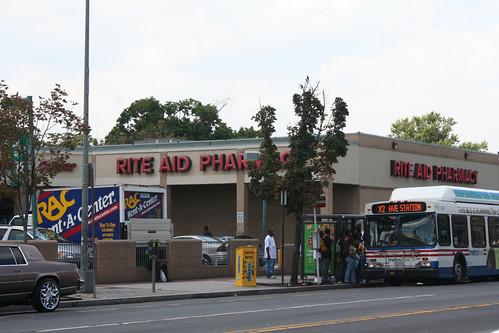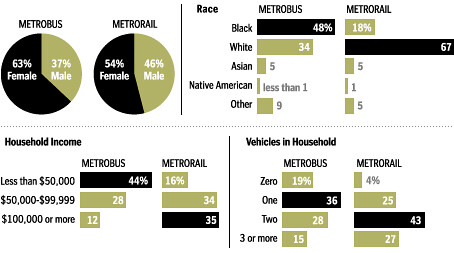Traffic and throughput

Image of the X2 bus at H Street Connection, 8th and H Street NE, Washington, DC. Image by Inked78.
Greater Greater Washington opines, in "The only thing we have to fear is fear of traffic," about how appointed and elected officials as well as other stakeholders (i.e., automobile drivers) think about traffic and mobility.
It happens that mobility throughput has been on my mind for the past few days for a couple reasons. First, I learned about the website European Platform on Mobility Management. "Mobility management" is the term used in Europe for what we often call "transportation demand management." Still, if you look through the EPOMM site, you will find a very thorough and rigorous approach to thinking about mobility.
Second, I haven't gotten around to writing about Arlington County's success with transportation demand management leading to fewer vehicle trips -- 38,000 fewer last year!
Third, last night I went to a public meeting on the C Street, NE Project on the edge of Capitol Hill in DC. (I really went because last night's presentation featured one of the nation's foremost experts in planning for green sidewalk and street infrastructure, and I wanted to get up to speed on the issues. It was well worth going, just for that. And I apologize for forgetting to mention that meeting, as well as ACT's meeting featuring Bill Lind, co-author of the book Moving Minds: Conservatives and Public Transportation, published by Reconnecting America. Both were last night.)
This project is attempting to mediate the demands for providing high-capacity street routes into and out of the city, in large part to serve commuters, while recognizing that at the same time, streets like C Street are "neighborhood" streets too, serving residents, and fronting their houses, and that the quality of life adjacent to traffic sewers is often not positive.
Mediating between these two very different demands is difficult. Interestingly, the traffic flow is extremely imbalanced, with something like 12,000 vehicles coming onto the street westbound from East Capitol during the morning rush hour, but with fewer than 8,000 vehicles using the road going eastward to leave the city during the evening rush hour.
Fourth, this morning I got into an e-argument, on the concerned4dcps e-list of all places, about streetcars on H Street. People on the list, who otherwise claim to be advocates for the poor and downtrodden, at the same time don't question the "privileging" of car ownership (using the word "privileging" in this way is an academic sociology-cultural studies technique for shaping discussions about class, privilege, ethnicity, etc.) seem to think that it's more important for cars to move on the street, than transit vehicles.
This is about the automobility paradigm first and foremost.
So on the train ride to Baltimore, I was thinking about this in the context of H Street, in terms of buses vs. vehicles in terms of passenger throughput, but also in terms of the improvements that would come to the quality of service, if bus service could be replaced by streetcar service.
According to the H Street Corridor Transportation Study from 2003-2004, about 24,000 vehicles use H Street daily. It's higher on Benning Road, and it splits down, with traffic diverting to Maryland Avenue, Florida Avenue, and Bladensburg Road.
Figuring that the average vehicle carries something like 1.2 passengers, about 28,800 people were transported on H Street for a 24 hour period.
The X bus service on H Street carries about 15,000 passengers each day. The service is provided by a mix of buses that are either 40 or 60 feet long. A 40 foot bus takes up the space equivalent to two cars, a 60 foot bus takes up the space equivalent to 3 cars.
According to the bus schedule for the X2 line, there are 131 buses providing service going westbound for an approximately 22 hour period (during the week). There are 149 buses providing eastbound service for the same period. For argument sake, let's say the average size of each bus is 50 feet.
So going westbound the buses take up the space equivalent of 327.5 vehicles. The buses carry about 7,500 people, while the space equivalent if used as cars would move 393 people.
Going eastbound, the buses take up the space equivalent of 372.5 vehicles. The buses carry about 7,500 people, while the space equivalent if used as cars would move 472 people.
Which is a more efficient use of scarce road resource?:
- 24,000 cars, trucks, and the occasional motorcycle carrying 28,800 people? or
- 280 buses carrying 15,000 people?
From a space standpoint, figuring an average vehicle length of 20 feet, the 24,000 vehicles take up 480,000 linear feet of space on the road, while the buses take up 14,000 linear feet of space in total in their time on the road.
Another way to think of this is that the buses use 7/240 of the space of the vehicles to move about 1/3 of the total throughput of people transported on the corridor in one 24 hour period.
... At the meeting last night, I finally learned a definitive number (one I had kind of imputed before) for the lane capacity of one mile of road during one hour in a street condition with multiple traffic signals and entry points/curb cuts. It's 850 vehicles per hour. (On an unimpeded freeway it's about 2,000-2,200 vehicles per hour.)
So why should automobile owners be privileged users of road space at the expense of transit riders? Shouldn't this be about optimal use of scarce resources? We care about sustainability don't we? And we care about equity too, right?

Transit rider demographics, Washington DC region. Washington Post graphic, 2005 -- click through for a larger image.
What I find particularly tiresome is that people who purport to represent the underrepresented (in DC, that means African-Americans and other people of color, and people who are less well off financially or even significantly impoverished) favor automobility more, not realizing that they are arguing against improvements in the quality of transit service -- switching out bus service for streetcars -- when currently, ridership demographics show that bus riders are more likely to be African-American and more likely to be lower income?
------------
Also see "Agustin (and many others) have a hard time hopping on the bus," which discusses Lyndsay Layton's long article from in the Washington Post from December 2005 on bus transit in the DC region, "Progress Has Passed Metrobus By: Outdated System Is Plagued by Unreliable Schedules, Inefficient Routes."
Labels: car culture and automobility, demographics, progressive urban political agenda, transportation planning, urban revitalization



0 Comments:
Post a Comment
<< Home